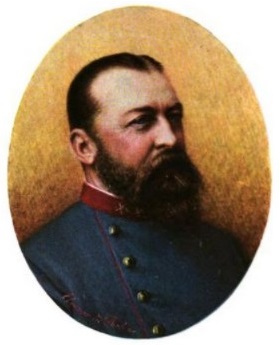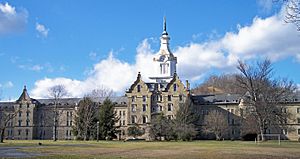Richard Snowden Andrews facts for kids
Quick facts for kids
Richard Snowden Andrews
|
|||||||||||
|---|---|---|---|---|---|---|---|---|---|---|---|

Portrait by Hallwig
|
|||||||||||
| Born | October 29, 1830 District of Columbia |
||||||||||
| Died | January 5, 1903 (aged 72) | ||||||||||
| Buried |
Green Mount Cemetery,
Baltimore, Maryland |
||||||||||
| Allegiance | |||||||||||
| Service/ |
|||||||||||
| Years of service | 1861–1865 | ||||||||||
| Rank | |||||||||||
| Unit | |||||||||||
| Battles/wars | American Civil War | ||||||||||
| Spouse(s) | Mary Catherine Lee | ||||||||||
| Relations | Col. Timothy Andrews (father) Col. Charles Marshall (brother-in-law) |
||||||||||
|
|||||||||||
Richard Snowden Andrews (born October 29, 1830 – died January 5, 1903) was a talented American architect. He also served as a military leader and diplomat for the Confederacy during the American Civil War.
Contents
Early Life and Architecture
Richard Snowden Andrews was born in the District of Columbia. He later moved to Baltimore, Maryland. His father was Colonel Timothy Andrews.
Richard became a well-known architect before the Civil War. He designed several important buildings. One of his most famous works is the Weston State Hospital in West Virginia. This building is the largest hand-cut stone structure in America. It was built in the Gothic Revival and Tudor Revival styles.
Andrews also designed the Maryland Governor's residence in Annapolis. He helped design the south wing of the U.S. Treasury Building in Washington, D.C. His sister married Charles Marshall, who later became a key helper for General Robert E. Lee during the war.
Andrews in the Civil War
During the American Civil War, Andrews helped create the First Maryland Light Artillery unit. He was later promoted to major. This meant he was in charge of a group of artillery batteries.
First Wounds and Return to Battle
Andrews was first wounded in July 1862 during the Seven Days Battles. In August of that year, he was a 31-year-old major. He was leading General Charles S. Winder's artillery. During a battle, he was badly wounded in his stomach.
Despite his severe injury, he held on to his intestines and fell from his horse. Doctors believed he would not survive. One surgeon said there was only a "one in a hundred" chance. Andrews famously replied, "Well, I am going to hold on to my one chance." The surgeon stitched him up.
Amazingly, Andrews recovered within eight months. He even had a silver plate placed over his wound. He then returned to his unit. However, he was wounded again at the Second Battle of Winchester. Around this time, he was promoted to colonel.
Diplomatic Mission to Germany
After recovering from his third wound, Andrews was given a new assignment. He was sent to Germany as an envoy. His mission was to negotiate for weapons for the Confederacy. He and another Confederate envoy tried to get arms from the German High Command.
The story goes that Andrews showed his old wound to German military advisors. They were so impressed by his bravery and survival. They called in General von Moltke, a top military advisor. Von Moltke was also very impressed. He agreed to sell the Confederacy the weapons they needed.
However, there was an ironic twist. As Andrews was returning to America, the South surrendered at Appomattox in April 1865. The weapons were never delivered.
Later Life and Family
After the war, Andrews vowed not to return to the United States. He went to Mexico instead. There, he joined Emperor Maximillian's Army and became a General. But in 1867, Emperor Maximillian was executed. Andrews then returned to his properties in Maryland.
He married and started a family. His daughter, Carolyn Snowden Andrews, married Gibson Fahnestock. Gibson was the son of Harris C. Fahnestock, a famous New York banker. Harris C. Fahnestock was known for selling Union war bonds during the Civil War. Some people joked that he helped the Union win the war through his bond sales.
The Maryland Center for History and Culture in Baltimore has some of Andrews's clothing. This includes the coat he wore when he was badly wounded.
Selected Architectural Works
- 1857: Parsonage of Franklin Street Presbyterian Church, Baltimore, Maryland.
- 1858–1864: Weston State Hospital, Weston, West Virginia.
- 1867–1870: Eastern Female High School, Baltimore, Maryland.
- 1870: Maryland Governor's Residence, Annapolis, Maryland.
- South wing of the U.S. Treasury Building in Washington, D.C.


